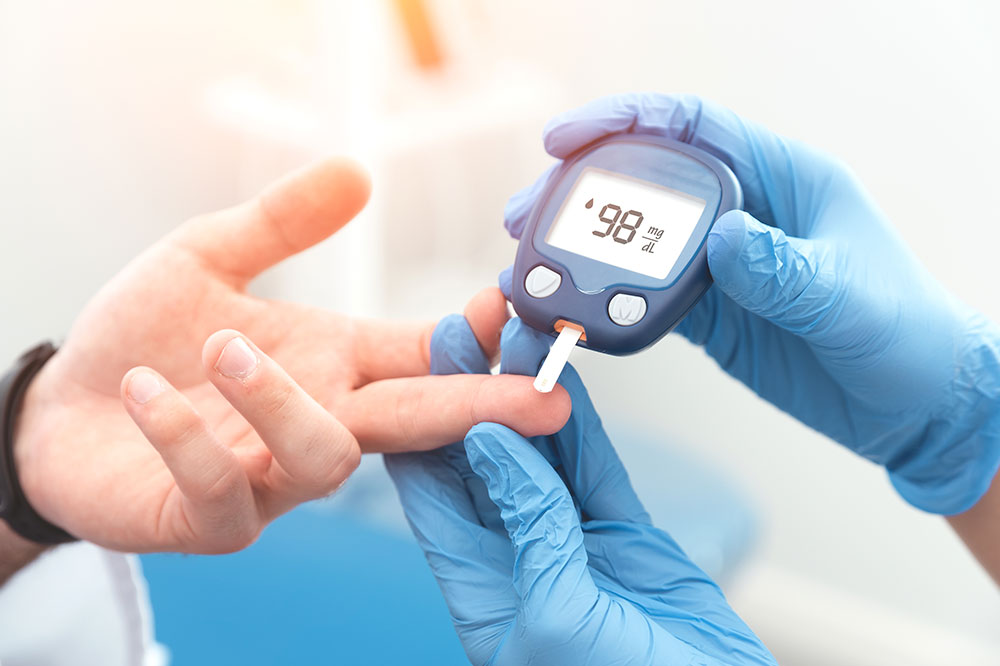
Diabetes – Signs, causes, and foods to eat
The pancreas is an internal organ that produces the hormone insulin. Insulin helps take glucose from our blood to our muscles, liver, and fat cells. If our pancreas does not produce enough insulin, the glucose remains in the blood. If our cells do not respond to insulin, our body becomes insulin resistant. Both of these scenarios lead to a rise in glucose levels in our blood and are called type 1 and type 2 diabetes, respectively.
Important signs and symptoms of diabetes
Though different reasons may cause type 1 and type 2 diabetes, the signs and symptoms remain the same. One must watch out for these symptoms:
- Persistent thirst
- Frequent urination, particularly in the night
- Continuous hunger, even after eating
- Persistent exhaustion without any cause
- Delayed healing of bruises or ulcers
- Dry and itchy skin
- Frequent tingling or pins and needles in feet
- Numbness in feet
- Blurred vision
Causes and risk factors of diabetes
Doctors have yet to find a cause for type 1 diabetes. For type 2 diabetes, they have identified many factors apart from insulin-related causes that increase its risk. The risk factors for both types of diabetes include the following:
- Sedentary or an inactive lifestyle
- Family history
- Hormonal diseases like Cushing’s Syndrome, hyperthyroidism, and acromegaly
- Gene mutations
- Insulin resistance
- High cholesterol
- High pressure
- Pancreatic diseases like pancreatitis, cancer, or trauma
- Certain treatment methods used for treating mental health disorders, seizures, and autoimmune diseases
- Immunosuppressants used to treat organ transplant
Short and long-term diabetic treatment
Taking insulin is the main treatment for type 1 diabetes. Regular and frequent monitoring of blood sugar levels and taking necessary steps to maintain cholesterol, weight, and blood pressure are also important parts of diabetes treatment.
Type 2 diabetes is a progressive disease. Treatment includes prescription treatments, healthy eating, and lifestyle changes. Doctors prescribe insulin injections only if oral treatment methods and lifestyle changes do not reduce blood sugar levels. It is essential not to take random insulin doses but to stick to the dosage according to the levels prescribed by one’s doctor.
Diabetes remedies to follow along with treatment
A person’s lifestyle and eating habits are equally, if not more, important than oral insulin or insulin injections. Here are some diabetes remedies to help one manage it naturally.
- Medical nutrition is an important part of diabetes treatment and is covered by Medicare if referred by the doctor. Plan a healthy meal with a dietician, and stick to the plan to manage sugar levels.
- Do not skip meals. Patients must always have some food or a diabetic-friendly snack in their bag, purse, school or office desk, and car.
- Eat five to six smaller meals instead of three large meals.
- Be physically active to manage weight, cholesterol, and blood pressure levels.
- Patients must use a glucose monitoring kit and record their daily glucose levels.
- One must have some candy in case sugar levels drop too low.
Foods that help in diabetes management
Choosing healthy foods from different food groups is key to planning a diabetic-friendly menu. Choose non-starchy, low-fat, low-carb, low-sugar foods, and foods with a low GI index. The best foods that help with diabetes management include the following:
- Vegetables like broccoli, carrots, greens, peppers, and tomatoes
- Fruits like oranges, apples, berries, and grapes
- Proteins like lean meat, fish, eggs, nuts, peanuts, or tofu
- Low-fat dairy products
- Healthy fats like tuna, mackerel, salmon, canola, olive oil, and avocado




